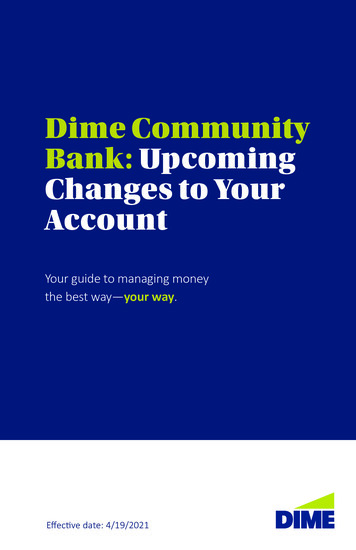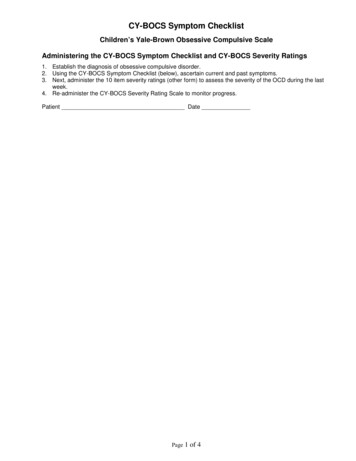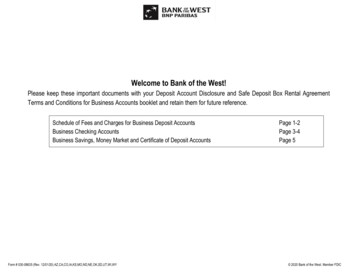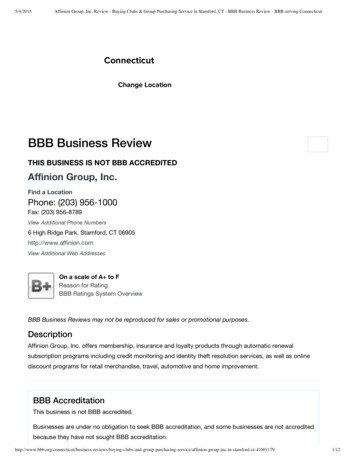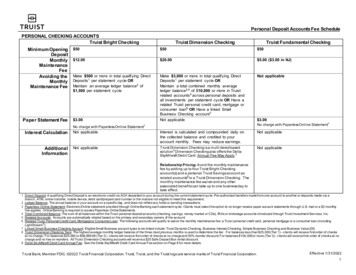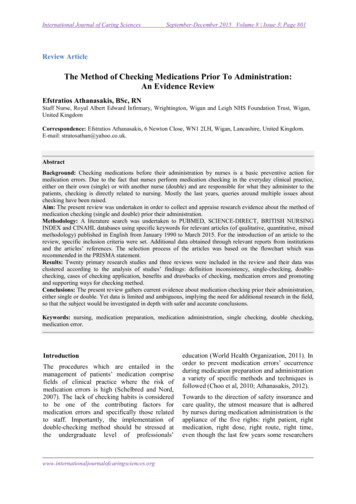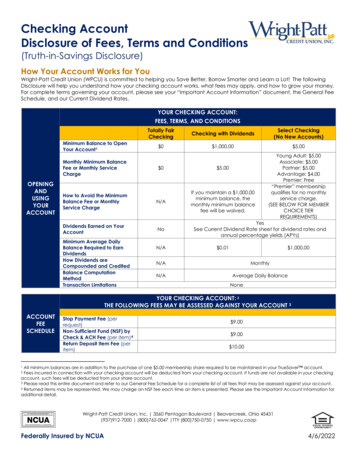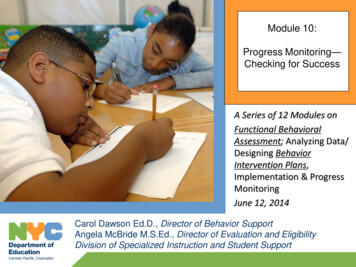
Transcription
Module 10:Progress Monitoring—Checking for SuccessA Series of 12 Modules onFunctional BehavioralAssessment; Analyzing Data/Designing BehaviorIntervention Plans,Implementation & ProgressMonitoringJune 12, 2014Carol Dawson Ed.D., Director of Behavior SupportAngela McBride M.S.Ed., Director of Evaluation and EligibilityDivision of Specialized Instruction and Student Support
Series of 12 Modules on FBAModule 1. An Introduction to Functional BehavioralAssessment; Using D.A.S.H. to Define, Ask, See &Hypothesize about Behavior; and DEFINING BehaviorModule 2. The ABCs of Understanding Behavior—Antecedents, Behavior, Consequence, Function & SettingEventsModule 3. D.A.S.H. ASKING about Behavior: InterviewingStaff, Student & Parent/Caregiver (INDIRECT DATA)Module 4. D.A.S.H. SEEING Behavior: Observing theStudent (DIRECT DATA)2
Series of 12 Webinars on FBA (cont.)Module 5. D.A.S.H. HYPOTHESIS Verification: ComparingINDIRECT & DIRECT DATAModule 6. Choosing Data Collection Tools and Completingthe Hypothesis Statement with Baseline DataModule 7. Introduction to Behavior Intervention Planning(BIP) and the Competing Behavior Pathway; Looking atReplacement vs. Desired BehaviorModule 8. Function-Based Behavior Intervention Strategiesfor Antecedents, Setting Events and Consequences;Teaching New Behavior(s)3
Series of 12 Webinars on FBA (cont.)Module 9. Using the Behavior Intervention Plan to Implementand Evaluate (WHO will do WHAT by WHEN and HOW?)Module 10. Progress Monitoring—Checking for SuccessModule 11. Aligning the Functional Behavioral Assessmentand Behavior Intervention Plan with the IndividualEducation ProgramModule 12. Continuum of Multi-Tiered Systems of Support—What does this look like for Tier 1, Tier 2 and Tier 3?4
Webinar Downloads Module 10 PowerPoint Module 10 (Optional Forms): Form: Teacher’s Daily Chart of Problem Behavior and Alternative/ Replacement Behavior(Frequency Chart including Intensity, Duration & Latency)Form: Teacher’s Weekly Chart of Problem Behavior and Alternative/ Replacement Behavior(Frequency Charts with 60 Minute Intervals, 30 Minute Intervals and Blank Intervals)Form: Daily Behavioral Assessment (Generic and Case Study Anthony)Form: Progress Monitoring Weekly Data summary of Frequency, Intensity, Duration, and/or LatencyGuide: Graphing Procedures for FBA Baseline and BIP Progress MonitoringThree Graphs on One Page (Blank and Anthony)GraphThe THREE REQUIRED FORMS for FBAs and BIPs1.2.3.Functional Behavioral Assessment (December 2013)Behavior Intervention Plans (December 2013)Considerations for Positive Behavior Support Form (December 2013)can be downloaded with this webinar or accessed ecialEd/Behavior.html5
Module 10 Outcomes: Identifying data collection measures for progress monitoring ofproblem behavior and replacement behavior Computing progress monitoring data for frequency, intensity andduration and/or latency Graphing progress monitoring data Recording progress monitoring data onto NYC BehaviorIntervention Plan form6
Test your Knowledge1. In planning intervention, the “who”, “what”, “when” and“how” must be based on the within theFBA.o Functional hypothesiso Baseline datao The age of the student7
Test your Knowledge2. In identifying behavior intervention strategies, we do whichof the following:o Neutralize/eliminate setting eventso Add relevant triggers and remove irrelevant oneso Teach alternative, more efficient behavioro Add effective and remove ineffective reinforcerso All of the above8
Test your Knowledge3. We progress monitor the and theto measure the decrease in the problembehavior and the increase in the replacement behavioro FBA and BIPo Short-term and long term goalso Problem behavior, alternative/replacement behavior9
Test your Knowledge4. What is contextual fit?o Having everyone on the same pageo Making sure students with disabilities are placed in specialeducationo Feasible strategies that account for staff skills, availableresources and administrative supports10
Test your Knowledge5. Implementation planning includes identifying:o Who is responsible for implementing each part of the interventiono Describing the activities that will be involved and how these will bedoneo Scheduling the date by when each part of the plan will beimplementedo All of the above11
Module 10Progress Monitoring Data12
Behavior Intervention ProcessTwo Main aviorInterventionPlan)
Behavior Intervention TING BEHAVIOR PATHWAYSetting orBEHAVIOR INTERVENTION STRATEGIESSetting EventStrategiesAntecedentStrategiesBehavior TeachingStrategiesConsequenceStrategies
Linking FBA to sTeachingBehaviorStrategiesConsequenceStrategies15
Identifying Behavior Intervention StrategiesTeam identifies arange ofstrategies/interventions toaddress:Setting EventStrategiesEliminate orNeutralize Effectsof Setting uenceStrategiesPrevent/ Reduce“Triggers”Teach Alternative/ReplacementBehaviorReinforce Alternative/Replacement andDesired BehaviorPrompts forAlternative/Replacementand DesiredBehaviorTeach DesiredBehavior/Academic/Social Skills/OrganizationalSkillsResponse to ProblemBehavior (ReduceReinforcers)- Prevention- Teaching- ConsequencesWe consider the FUNCTION of the problembehavior when selecting these strategies.
Goal of theBehavioral Intervention roblemBehaviorBehavior176/12/2014
R.A.C.E.R.Replace problem behavior with a socially acceptable, efficientbehavior that allows the student to obtain the pay-off/function.Antecedent strategies are developed to directly addresstriggers to prevent problems & prompt replacement behaviorsbased on the function of behavior. We also use setting eventstrategies to neutralize or eliminate the setting event.Correct behaviors by quickly & effectively redirecting thestudent to replacement behaviorExtinguish behaviors by ensuring that problem behaviors doNOT pay off for the student (i.e. does not result in the function ofbehavior)Reinforce replacement & desired behaviors based onfunction/pay off for the student18
The Basic FBA to BIP Process1. Define the Problem Behavior2. Conduct assessment for behavior intervention planninga. Functional Behavioral Assessment Defining behavior in observable & measureable terms Ask staff, student & parent/caregiver about where, when, & why behavior occurs See the behavior(s) during specified classes/ subjects /activities Hypothesize a final summary of where, when, & why behavior occurs3. Design an individualized Behavior Intervention Plan (BIP) Ensure technical adequacy Ensure contextual fit4. Ensure Fidelity of Implementation5. Monitor Plan’s Impact on Student BehaviorAdapt BIP andimplementation as neededbased on on-goingmonitoringAdapted from Horner, Albin, Todd, Newton & Sprague, 2011
Summary Statement/ HypothesisCase Study AnthonySetting EventAntecedentAnthonyiscorrectedearlier inthe dayTeacherdirective tobegin workin Science/SocialStudiesBehaviorAnthonygets outof hisseatConsequence/FunctionLeaves Class/goes to AP’sOfficeAvoids task/Gains AdultAttention
Define Desired Behavior & ConsequenceDesired BehaviorCompleteworkSetting EventAntecedentAnthonyiscorrectedearlier inthe dayTeacherdirective tobegin workin Science/SocialStudiesBehaviorAnthonygets outof hisseatTypicalConsequenceSuccess withassignment; goodgrade; teacher praiseConsequence/FunctionLeaves Class/goes to AP’sOfficeAvoids task/Gains AdultAttention
Define Alternative/Replacement BehaviorCompleteworkSetting EventAntecedentAnthonyiscorrectedearlier inthe dayTeacherdirective tobegin workin Science/SocialStudiesBehaviorAnthonygets outof hisseatAnthony usesa hand signalto requesthelp, break,alternate taskSuccess wassignment; goodgrade; praiseConsequence/FunctionLeaves ClassAvoids TaskAcceptableAlternativeBehavior
Linking FBA to sTeachingBehaviorStrategiesConsequenceStrategies23
Behavior Intervention Plan Strategies Implementation PlanCase Study AnthonySetting Event StrategiesHow will you neutralize orprevent setting events?Check-in with Anthonybefore entering theclassroomTeach self-regulationstrategiesAntecedent StrategiesHow will you change theenvironment to reducetriggers for problembehavior(s) and increasesuccess of new behavior(s):Teacher will privately promptAnthony to begin workRemind Anthony that he canrequest a break if he needs itby using a hand signalProvide a choice of tasksbased on reading ability(intersperse group andindividual tasks to encouragecollaboration with peers).Teaching StrategiesAlternative/ReplacementBehaviorTeach hand signals toexpress needsHow will you teach newbehaviors?Teach Anthony to use a handsignal to request help/ break /additional time / transition toa new taskTeach Anthony to use selfregulation strategies whenfrustratedConsequences StrategiesResponse after newbehavior(s) occur (increasereinforcer):Anthony earns points forextra reading or computertime when he completes theassigned taskAnthony receives a weeklynote home documenting hissuccess in task completionAnthony earns preferredtime with the AP at lunchResponse after problembehavior(s) occur (reducereinforcer):Anthony does not gainaccess to the AP’s officewhen he leaves hisseat/room, but will completework in the resource room.
ImplementationPlanningBehavior InterventionPlanning ProcessTasksPersonResponsibleByWhenTools /Data CollectionMethodsReview Date:EvaluationDecisionContinue? Y or NModify?Y or NPrevention:Make problem behavior irrelevantSEABCWhat Strategies to Neutralize orPrevent Setting Events: How will you change theenvironment to reducetriggers for problembehavior(s) and increasesuccess of newbehavior(s)?SEATeaching:Make problem behavior inefficient Replacement Behavior(s): How will you teach newbehaviors?BConsequences:Make problem behavior ineffective Response after newbehavior(s) occur(increase reinforce): Response after problembehavior(s) occur (reducereinforcer):C25
ImplementationPlanningBehavior InterventionPlanning ProcessTasksPersonResponsiblePrevention:Make problem behavior irrelevantWhat Strategies to Neutralize orPrevent Setting Events: How will you change theenvironment to reducetriggers for problembehavior(s) and increasesuccess of newbehavior(s)?WhoByWhenWhenTools /Data CollectionMethodsReview Date:EvaluationDecisionContinue? Y or NModify?Y or NHow &tools tomeasureTeaching:Make problem behavior inefficient Replacement Behavior(s): How will you teach newbehaviors?Consequences:Make problem behavior ineffective Response after newbehavior(s) occur(increase reinforce): Response after problembehavior(s) occur (reducereinforcer):26
Data Collection forProgress MonitoringLooking at theImplementation Plan27
Anthony’s Implementation Plan for BIPTasksStaffResponsibleByWhen7th grade staff12/20/13Tools / DataCollectionMethodsPreventionHow will you neutralize orprevent setting events?Check-in before each classHow will you change theenvironment to reducetriggers for problembehaviors(s) and increasesuccess of new behavior(s):Prepare materials to hisinstructional level &preferencesRemind him to use handsignals to express needs28Daily BehavioralAssessmentSheetMaterials guidedby IEP &assessment ofinstructional leveland preferences
Anthony’s Implementation Plan for BIP (cont.)TasksStaffResponsibleByWhenLesson Plans forhand h hand signals to expressneedsHow will you teach newbehaviors?Refer to IEP for neededacademic supports & socialskills lessons infrustration/anger mgmt. andself-monitoring29Tools / DataCollectionMethods7th grade staff 12/20/13and Ms. A(counselor)Lesson Plans forfrustration/angermgmt.Staff ProgressMonitoring ToolStudent selfmonitors withDaily BehavioralAssessmentSheet
Anthony’s Implementation Plan for BIP (cont.)TasksConsequencesResponse after newbehavior(s) occur (increasereinforcer):Anthony earns points whichgive him extra reading orcomputer time and selection ofnew book from AP’s officeduring lunch period.Response after problembehavior(s) occur (reducereinforcer):Anthony will not go to Mr. G.(A.P.) if he leaves class, butwill complete work in resourceroom30StaffResponsibleBy WhenTools / DataCollectionMethods7th GradeStaff12/20/13Daily BehavioralAssessmentSheetMr. G (A.P.)Data gathering &analysisPositive noteshomeResource RmTeacherProgressMonitoring Tool
Measures for Progress MonitoringMeasurePurposeDurationRecord length of time that student engages in behaviorLatencyRecord length of time before the behavior occursFrequencyRecord how often a behavior occursIntensityRecord severity of behavior Use the same measure(s) for Progress Monitoring ofProblem Behavior that were used to develop the BaselineData Decide which measure(s) to use for Replacement/AlternativeBehavior during Progress Monitoring31
Suggested Data Collection Tools for BIPProgress MonitoringExamine Handouts: Teacher’s Daily Chart of Problem Behavior andAlternative/Replacement Behavior including Intensity,Duration & Latency (Blank and Case Study Anthony) Teacher’s Weekly Chart of Problem Behavior andAlternative/Replacement Behavior—Frequency Charts Point System: Daily Behavioral Assessment (Blank andCase Study Anthony)32
Let’s Examine the Form33
Let’s Examine the Forms34
Let’s Examine the Form(Blank & Case Study Anthony)35
Summarizing and Analyzing ProgressMonitoring DataFrom Handouts:Review Data Summaries and Averages for Anthony’sBaseline Data (from Webinar 6)Compute Data Summaries and Averages for Anthony’sProgress Monitoring Week 1 and Week 236
Let’s Examine the Form (Case Study Anthony)37
Review Anthony’s Baseline Data(Handout)Baseline DaysFrequency[Frequency COUNTof NUMBER of TIMESthe behavioroccurred](Example: 2 times”gets out-of-seat” onDay 1)Day 1Day 2Intensity[Intensity SEVERITY (1-5)level defined below](Example: 13 min and 5min on Day 1)(Example: Level 3 andLevel 1 on Day 1)13 min35 min110 min3Latency[Latency LENGTH ofTIME delay fromantecedent to start the ofbehavior](Example: 6 min and 9min on Day 1)N/A2 times1 timeTotals frequency16 times/10 daysBaselineAverages1.6 times per day or8 times per week (5 days)Range: 1 to 2 perdayRange: Low to HighDuration[Duration LENGTH ofTIME behavior occurred] 16128 min 1649 16N/A8 minutes each timeLevel 3N/ARange: 5 to 13 minRange: 1 to 5Range: to min38
Summary Progress Monitoring Data FormincludingProgressMonitoringDaysFrequency, Duration, Intensity & LatencyFrequency[Frequency COUNTof NUMBER of TIMESthe behavioroccurred](Example: 2 times onDay 1)Duration[Duration LENGTH ofTIME behavior occurred]Intensity[Intensity SEVERITY (1-5)level defined below](Example: 10 min and 6min on Day 1)(Example: Level 2 andLevel 3 on Day 1)Latency[Latency LENGTH ofTIME delay fromantecedent to start of thebehavior](Example: 6 min and 9min on Day 1)Day 1minminDay 2minminTotalstimes/ 5 daysminminutes # days frequency frequency frequencyAveragestimes per dayminutesLevelminutesRange: Low to HighRange: toRange: to minRange: toRange: to min39
Let’s Examine the Form(Blank & Case Study Anthony)40
Computing Anthony’s Progress Monitoring Data(Week 1) (Handout)ProgressMonitoringDaysFrequency[Frequency COUNTof NUMBER of TIMESthe behavioroccurred](Example: 2 times”gets out-of-seat” onDay 1)Day 1Intensity[Intensity SEVERITY (1-5)level defined below](Example: 13 min and 5min on Day 1)(Example: Level 3 andLevel 1 on Day 1)10 min38 min310 min32 timesDay 2TotalsDuration[Duration LENGTH ofTIME behavior occurred]1 time7 times/ 5 days 5# daysLatency[Latency LENGTH ofTIME delay fromantecedent to start ofthe behavior]Not applicable for thisbehavior.N/AN/A61 minutes16N/A minutes 7 frequency 7 frequency frequencyAverages1.4 times per day8.7 minutes2.3 LevelN/A minutesRange: Low to HighRange: 1 to 2Range: 7 to 10 minRange: 1 to 3Range: to min41
Computing Anthony’s Progress Monitoring Data(Week 2) (Handout)ProgressMonitoringDaysFrequency[Frequency COUNTof NUMBER of TIMESthe behavioroccurred](Example: 2 times”gets out-of-seat” onDay 1)Day 1Day 2TotalsDuration[Duration LENGTH ofTIME behavior occurred]Intensity[Intensity SEVERITY (1-5)level defined below](Example: 13 min and 5min on Day 1)(Example: Level 3 andLevel 1 on Day 1)Not applicable for thisbehavior.10 min38 min310 min3N/A2 times1 timeLatency[Latency LENGTH ofTIME delay fromantecedent to start ofthe behavior]N/A3 times/ 5 days23 minutes4N/A minutes 5 days 3 frequency 3 frequency frequencyAverages.6 times per week7.6 minutes1.3 LevelN/A minutesRange: Low to HighRange: 0 to 1Range: 5 to 7 minRange: 0 to 2Range: to min42
Graphing Procedures forFBA Baseline andBIP Progress Monitoring43
Examine the Actual Guide44
Case Study Anthony’s Baseline Data andProgress Monitoring Review data Chart Graph Summarize45
Goal of theBehavioral Intervention roblemBehaviorBehavior466/12/2014
ProgressMonitoringWeek 2ProgressMonitoringWeek 01012112221221Anthony's Out-of-Seat Behavior5ProgressMonitoringWeek 1Baseline4FrequencyBaselineAnthony’s Frequency Chart and GraphTarget Behavior: Getting Out-of-SeatProgressMonitoringWeek 2321012345678910 11 12 13 14 15 16 17 18 19 20Days47
ProgressMonitoringWeek 532.533322110201Anthony's Out-of-Seat Behavior6BaselineProgressMonitoringWeek 15Intensity (Scale 1-5)ProgressMonitoringWeek 1BaselineAnthony’s Intensity Chart and GraphTarget Behavior: Getting Out-of-SeatProgressMonitoringWeek 24321012345678910 11 12 13 14 15 16 17 18 19 20Days48
ProgressMonitoringWeek 5141681415818101491070605Anthony's Out-of-Seat Behavior20ProgressMonitoringWeek 1Baseline1816Duration (Total Time)ProgressMonitoringWeek 1BaselineAnthony’s Duration Chart and GraphTarget Behavior: Getting Out-of-SeatProgressMonitoringWeek 21412108642012345678910 11 12 13 14 15 16 17 18 19 20Days49
Three Graphs on One FormPurpose: Graph data all on one page Frequency, Intensity, Duration / Latency Compare and contrast data on each day Important to see the big picture of what’s happening each day50
EXAMINE ACTUAL FORM51
EXAMINE ACTUAL FORM FOR ANTHONY52
Goal of theBehavioral Intervention roblemBehaviorBehavior536/12/2014
ProgressMonitoringWeek 1920010111212154FrequencyProgressMonitoringWeek 1BaselineAnthony’s Chart & GraphReplacement Behavior: Use Non-Verbal Signal322211 1 1111000000000000123456789 10 11 12 13 14 15 16 17 18 19 20 2100Days54
NYCDOE Behavior Intervention Plan (December 2013)Progress MonitoringNYS Regulation: [200.22 (b) (5), [200.22(b)(4)(iii)]]Provide a schedule by which the effectiveness of the interventions/strategies will be measured.Please note: The results of the progress monitoring must be documented and reported to the student's parents and tothe CSE or CPSE and must be considered in any determination to revise a student's behavioral intervention planor IEP.Progress monitoring data must include the frequency, duration, intensity, and/or latency of the targeted problembehavior(s) as well measurement of the alternative/replacement behavior(s).Progress Monitoring Schedule must include:Specific behavior(s) being monitored (targeted problem behavior(s) & alternative/replacement behavior(s))Intervals at which data will be collectedWho is responsible for data collectionTools/data collection methods that will be usedThe team identified in this plan should meet to analyze data and evaluate the BIP no later than 2 weeks after initiationof the plan. Thereafter, the schedule to measure effectiveness of the BIP will be followed as specified below.55
NYCDOE Behavior Intervention Plan (December 2013)Progress Monitoring (cont.)Schedule to Measure Effectivenessof Interventions. Indicate intervalbelow (e.g., weekly, every 2 weeks,etc.)Baseline Data of ProblemBehavior(s) (e.g., frequency,duration, intensity and/or latency)Data on Problem Behavior(s) afterimplementation of BIP for thespecified interval. (e.g., frequency,duration, intensity and/or latency)Person ResponsibleAlternative/ReplacementBehavior(s)Data on Alternative Behavior(s)after implementation of BIP forthe specified interval. (e.g.,frequency, duration, intensityand/or latency)Person ResponsibleInterval:Start Date:End Date:Schedule to Measure Effectivenessof Interventions. Indicate intervalbelow (e.g., weekly, every 2 weeks,etc.)Interval:Start Date:End Date:56
Anthony’s Progress Monitoring DataSchedule to Measure Effectivenessof Interventions. Indicate intervalbelow (e.g., weekly, every 2 weeks,etc.)Interval: weeklyStart Date: 12/20/2013End Date: 1/15/2014Schedule to Measure Effectivenessof Interventions. Indicate intervalbelow (e.g., weekly, every 2 weeks,etc.)Interval: weeklyStart Date: 12/20/2013End Date: 1/15/2014Baseline Data of ProblemBehavior(s) (e.g., frequency,duration, intensity and/or latency)Data on Problem Behavior(s) afterimplementation of BIP for thespecified interval. (e.g., frequency,duration, intensity and/or latency)Person ResponsibleAfter Week 1Frequency: 1.4 times/day (Range 12)Intensity:2.2 (Range 1-3)Duration:12.2 min. (Range 10-18)After Week 2Frequency: .6 times/day (Range 0-1)Intensity:1.3 (Range 0-2)Duration:3.6 min. (Range 0-6)All academic teacherswill use ProgressMonitoring tool andsubmit to Mr. G (theAP) by 1/16. Reviewmeeting will be ta on Alternative Behavior(s) afterimplementation of BIP for thespecified interval. (e.g., frequency,duration, intensity and/or latency)Person ResponsibleAnthony will use a Daily BehavioralAssessment Chart and earn pointswhen he: 1) uses the hand signalsto communicate with his teacher;2) Checks in with each teacherbefore class; 3) completes classassignments to the best of ability;4) stays in the classroomAfter Week 1:Frequency: .6 times per dayAll academic teacherswill use ProgressMonitoring tool andsubmit to Mr. G (theAP) by 1/16. Reviewmeeting will be held1/17/2014. Anthonywill complete the dailyBehavioral Assessmentsheet.Getting out of seat:BaselineFrequency: 1.6 times/day (Range 12)Intensity: 3 (Range 1-5)Duration: 8 min. (avg.) (Range 5min. to 13 min.)After Week 2:Frequency: 1.4 times per day57
Check for Understanding1. Which data collection measures should be used for:a) Progress Monitoring for the Problem Behavior?b) Progress Monitoring for the Replacement Behavior?58
To be continued Looking forward to seeing you on June 16th, 2014 forModule 11:Aligning the Functional Behavioral Assessmentand Behavior Intervention Plan with theIndividual Education Program59
AcknowledgementsWe would like to acknowledge the resources and materialsfrom the National Technical Assistance (TA) Center onPositive Behavioral Interventions and Supportswww.pbis.org, from which many of the activities andmaterials are adapted.The TA Center on Positive Behavioral Interventions andSupports has been established by the Office of SpecialEducation Programs, US Department of Education to giveschools capacity-building information and technicalassistance for identifying, adapting, and sustainingeffective school-wide disciplinary practices.60
Identifying data collection measures for progress monitoring of problem behavior and replacement behavior Computing progress monitoring data for frequency, intensity and duration and/or latency Graphing progress monitoring data Recording progress monitoring data onto NYC Behavior Intervention Plan form . 6
